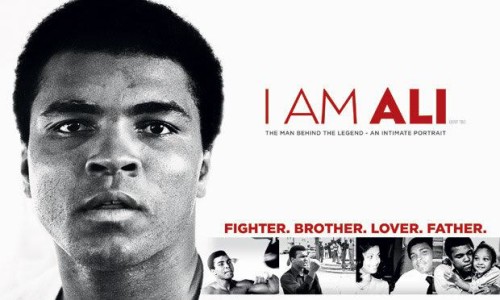
Written by Rachael Johnson.
Only children should have heroes and heroines, but if there is a hero worthy of worship it is Muhammad Ali. Ali was not only a supreme boxer; his extraordinary charisma granted him enormous celebrity outside the ring and he transcended his profession to become one of the most important cultural figures of the ’60s and ’70s. Ali was, and remains, a symbol of Black pride and consciousness in both the United States and abroad. Even today, young people from Cuba to Ghana are familiar with his name and achievements. Ali was diagnosed with Parkinson’s Disease in the early ’80s but it has not prevented him having an active public life. He became an advocate for those with the condition and devoted himself to humanitarian work. Ali is now a revered figure in the United States but this was not always the case. Many in the white establishment and mainstream media hated him. They saw Ali’s conversion to Islam as a threat and despised him for refusing to fight in the monstrosity that was the Vietnam War. The boxer was punished for refusing military service: his heavyweight title was taken away from him and he was banned from boxing for four years from 1967 to 1971. On the sorrowful day Ali leaves us, hypocrites who reviled him will, no doubt, express condolences and the mainstream media will try to depoliticize and deradicalize him like they did with Mandela.

There have been numerous narrative and documentary films devoted to Muhammad Ali. The most well-known biopic of this century is probably Michael Mann’s Ali (2001) starring Will Smith in the title role. There have also been several excellent documentaries on the boxer. The recently released documentary, The Trials of Muhammad Ali (Bill Siegel, 2013) examines the political fight Ali had outside the ring when he refused to fight in Vietnam. Note that the television film Muhammad Ali’s Greatest Fight, also released in 2013, deals with the legal battle. Many documentaries have studied his legendary fights inside the ring. When We Were Kings (Leon Gast, 1996) examines Ali’s celebrated 1974 fight against George Foreman in the Central African nation then called Zaire (the present-day Democratic Republic of Congo) although it does so much more than anatomize the bout. It is a stirring portrait of an epoch-defining cultural and political event. Although it also examines the public, political Ali, Claire Lewins’s I Am Ali (2014) focuses on the boxer’s private self.

I Am Ali features interviews with people close to Ali, among them his former manager, Gene Kilroy, trainer, Angelo Dundee (who died in 2012), brother, Rahaman Ali and son, Muhammad Ali Jr. Crucially, the documentary gives voice to Ali’s ex-wife, Veronica Porsche, and daughters Hana and Maryum. There are not many profiles of male boxers that feature female public and/or private voices. Lewins has also greatly benefited from access to taped recordings of conversations Ali had with his children. Intended as childhood audio journals, they lend an incalculable poignancy to the film. I Am Ali is, in fact, extremely moving. Hearing the boxer singing Mamas and the Papas songs with 3-year-old Hana makes you cry. Commentary by his daughters indicate that Ali was a great father despite his hectic travelling schedule. Maryum and Hana describe a playful, loving personality. Ali was an inspirational man to his loved ones too. We hear him asking Maryum when she was little: “If everyone’s born for a purpose, what do think you were born for?” Ali was not, it seems, an uneasy, distant patriarchal figure. His masculinity was characterized by deep emotional expressiveness. Lewins’s employment of beautiful family photos, home movies and those engaging recordings serve to reinforce the impression.

As a husband, the younger Ali was, reportedly, more complicated. Although an intimate portrait of the man, the documentary does not examine his marital and romantic life in depth. Lewins, however, rightly allows a tearful Veronica to describe her “fairy tale days” with Ali and more painful ones: “He’s a really good-hearted person, very sensitive, and I guess I’m crying because of his situation now. You know, and I’ll always love him, I mean not like ‘in love’…we’ve always been friends. It became hard to live with him because, everyone knows, the whole world knows, he wasn’t faithful as a husband. There’s a story to that too, but I think but he’s an incredible human being. He has a beautiful heart…” Is I Am Ali hagiography? Perhaps. What is clear, though, is that Ali was, and is, much loved by people close to him.

Clare Lewins not only incorporates private, female voices in her documentary; I Am Ali also features an interview with a boxing fan, Russ Routledge, from Newcastle in the North East of England who once stayed with Ali in his home in the States. In doing so, she exhibits both a feminist and populist consciousness in her portrait of the boxer. The British director, further, examines Ali’s warm relationship with the United Kingdom. Lewins tells the improbable tale of his visit to South Shields (also in the North East of England) where his marriage to Veronica was blessed in the local mosque. This is of personal interest to me as it is the town where I was born.

Although it focuses on the private Ali, the documentary also addresses the public and political aspects of the man. I Am Ali is graced with fantastic iconic shots of the boxer and remarkable archival footage of powerful old interviews and speeches. Ali spoke out against racial injustice and the documentary features a potent, witty speech on white supremacist indoctrination by the boxer. It examines his growing political awareness and chronicles his conversion to Islam as well as his refusal to fight in Vietnam. Ali’s refusal to fight, in my mind, remains the most courageous thing he has ever done in his courageous, wonderful life. I Am Ali features the boxer’s memorable statement about his decision: “Why should me and other so-called negroes go ten thousand miles away from home here in America to drop bombs and bullets on other innocent brown people who’s never bothered us and I will say directly no I will not go ten thousand miles to help kill innocent people.”

I Am Ali is, perhaps, not the finest documentary about the legendary boxer. The fascinating and thrilling When We Were Kings remains a personal favourite. It is is, nevertheless, an insightful and tender exploration of both the public and private Ali. Giving voice to the man himself and those closest to him, it is a deeply emotional ode to both family love and noble ideals.





